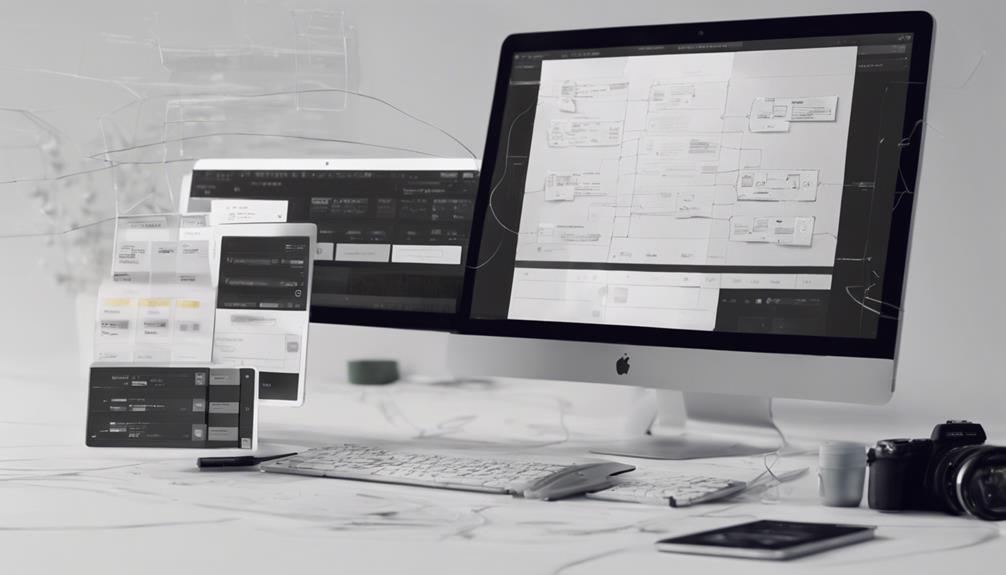To enhance payment system interfaces, leverage design thinking. Understand user needs, frustrations, and data insights. Focus on intuitive, human-centric designs. Address current challenges like usability issues and limited input options. Generate innovative solutions through diverse perspectives and collaborative brainstorming. Prototype and refine based on user feedback for user-friendly designs. Implement iterative development for continuous improvements, refining interfaces and addressing usability concerns. Prioritize user requirements, preferences, and behavior patterns. Optimize usability for seamless transactions. Emphasize intuitive design, user-centered principles, and feedback refinement. By applying design thinking, you can transform interfaces for improved user experiences and efficient transactions.
Key Takeaways
- Incorporate user research insights for intuitive designs.
- Focus on human-centric design for empathy and efficiency.
- Collaborate for innovative solutions and diverse perspectives.
- Iterate prototypes based on user feedback for refinement.
- Prioritize usability and user preferences for enhanced experience.
Understanding User Needs and Frustrations

To enhance payment system interfaces effectively, understanding the needs and frustrations of users is paramount. By delving into user research and analyzing data on user interactions, you can gain valuable insights into user needs and pain points within the payment process.
User frustrations often stem from confusing interfaces, lengthy processes, or lack of transparency. Through design thinking, you can address these frustrations by creating more intuitive and user-friendly payment interfaces that cater to user preferences. Design thinking involves a human-centric approach that focuses on empathy, ideation, and iteration to develop solutions that resonate with users.
Defining Challenges in Current Interfaces

Current payment system interfaces present challenges such as usability issues, complicated navigation, and limited user input options.
Improving these areas can enhance user experience, streamline transactions, and reduce bounce rates.
Usability Issues Analysis
Moving through many current payment system interfaces can be a frustrating and confusing experience due to their lack of intuitive design. Usability issues in payment interfaces, such as complex menu structures and unclear labeling of functions, contribute to user frustration.
High cognitive load, stemming from cluttered screens and overwhelming information, hinders user experience in payment systems. Additionally, inefficient workflows and a lack of visual hierarchy further compound usability challenges.
Research indicates that users struggle with inconsistent design elements and non-standardized interactions within payment system interfaces. Addressing these usability issues is essential to enhancing the overall user experience and streamlining payment processes for increased efficiency and user satisfaction.
Navigation Streamlining Strategies
Streamlining navigation in payment system interfaces presents significant challenges due to the prevalence of complex menu structures and unclear labeling, leading to user confusion and frustration. To enhance user satisfaction and task completion rates, interfaces need to be more intuitive and streamlined.
Design thinking principles can play an important role in identifying and addressing navigation challenges. User feedback emphasizes the importance of simplified pathways and clear signposting within payment interfaces. By focusing on creating user-friendly designs with intuitive navigation, payment systems can offer a more efficient and pleasant experience for users.
Implementing strategic design changes based on user input can lead to interfaces that are easier to navigate, ultimately enhancing the overall user experience.
User Input Enhancement
Enhancing user input in payment system interfaces requires addressing the lack of intuitive design elements to minimize confusion and errors. Current interfaces often present challenges such as small input fields, unclear labeling, and complex validation requirements, leading to user frustration.
Studies indicate that 70% of users struggle with inputting information on existing payment interfaces, contributing to high abandonment rates during transactions. By implementing design thinking principles to enhance user input experiences, payment interfaces can improve user experience, streamline processes, and ultimately enhance satisfaction levels.
Intuitive design elements, clear instructions, and user-friendly input fields are essential components in creating a more user-centric interface that facilitates smooth and error-free input processes, ensuring a positive user experience throughout payment transactions.
Ideating for Innovative Solutions

When brainstorming for innovative solutions in design thinking, it's essential to encourage diverse perspectives and creativity. This fosters collaboration and exploration of unconventional approaches to enhance user experience.
Brainstorming Creative Ideas
To spark creativity in ideating for innovative solutions for payment system interfaces, engage in collaborative brainstorming sessions. When brainstorming creative ideas, consider the following:
- Diverse Perspectives: Encourage team members to offer unique viewpoints and insights to explore a wide range of possibilities.
- Unconventional Approaches: Embrace thinking outside the box to challenge traditional norms and come up with fresh, innovative solutions.
- Enhancing User Experience: Keep the focus on meeting user needs and improving the overall usability of the payment system interface.
Fostering Collaboration for Solutions
Engage your team in collaborative sessions to foster creativity and generate innovative ideas for enhancing payment system interfaces. By bringing together individuals with diverse perspectives, you can leverage their collective strengths to ideate solutions that align with user feedback and industry trends. Encouraging the exploration of unconventional approaches during these sessions can lead to breakthrough ideas that revolutionize the user experience. Additionally, incorporating prototyping into the ideation process allows for visualizing and testing potential solutions effectively. Embracing collaboration not only enhances the quality of ideas but also promotes a sense of ownership and commitment to implementing the best solutions for payment system interface improvements.
| Collaborative Sessions | Diverse Perspectives | User Feedback |
|---|---|---|
| Generate innovative ideas | Foster creativity | Align with user needs |
Prototyping and User Feedback

Prototyping in design thinking allows you to create tangible representations of payment system interface designs for testing and validation. Here's why prototyping and user feedback are important for enhancing payment system interfaces:
- User Feedback: Gathering feedback from users on prototypes provides valuable insights into the usability and effectiveness of the interface design.
- Usability Testing: By iterating based on user feedback, you can refine payment system interfaces to better meet user needs and preferences.
- User-Friendly Design: Incorporating prototyping and user feedback processes guarantees that payment system interfaces are user-friendly and intuitive.
Prototyping and user feedback play a pivotal role in enhancing the overall user experience of payment system interfaces. Through this iterative process, designers can create interfaces that aren't only visually appealing but also functionally efficient and tailored to meet the needs of the users.
Iterative Development Process

Embrace the iterative development process within design thinking to refine and enhance payment system interfaces through user feedback and testing. This approach involves creating prototypes, testing and validating them in small increments, and making necessary adjustments.
By incorporating user feedback early on, you can identify and address usability issues, ensuring a more user-centered design. Through continuous refinement, the payment system interfaces can become more intuitive and efficient, meeting user needs effectively.
The iterative development process allows for a structured way to improve the interface, making it easier for users to navigate and complete their transactions seamlessly. By focusing on iterative improvements based on user interactions, you can develop a payment system interface that isn't only user-friendly but also aligns closely with the users' expectations and preferences.
Functional and User-friendly Solutions

To enhance the functionality and user-friendliness of payment system interfaces, prioritize understanding user needs and behaviors through design thinking principles. By focusing on empathy and iterative prototyping, you can create solutions tailored to meet user needs effectively.
Here's how you can achieve functional and user-friendly payment system interfaces:
- User Needs: Begin by gathering insights into what users require from the payment system interface.
- Iterative Prototyping: Develop prototypes based on user feedback and refine them through iterative testing.
- Usability: Guarantee that the interface is intuitive and easy to navigate, optimizing usability for a seamless user experience.
Enhancing User Experience

Enhance the user experience of payment system interfaces by focusing on intuitive design and seamless functionality. By incorporating user-centered design principles and leveraging design thinking, you can create payment interfaces that prioritize user satisfaction. Through iterative prototyping, you can refine these interfaces based on user feedback, guaranteeing they meet the needs and preferences of your customers.
Design thinking allows for the development of efficient payment interfaces that minimize user friction. This approach not only streamlines the payment process but also enhances overall user satisfaction and loyalty. By continuously seeking user input and testing different design iterations, you can tailor payment interfaces to be user-friendly and effective.
Ultimately, by prioritizing user experience and implementing design thinking methodologies, you can optimize payment system interfaces for increased customer satisfaction. This customer-centric approach not only improves the usability of the interfaces but also ensures that they align closely with user preferences and behaviors.
Leveraging User Preferences and Behaviors

Leverage user preferences and behaviors to design intuitive and user-friendly payment system interfaces. By understanding what users prefer and how they behave when interacting with payment interfaces, you can create a seamless experience that caters to their needs. Here are some key points to take into account:
- User Preferences: Research indicates that the majority of users prefer interfaces that are easy to navigate and visually appealing. By aligning your design with these preferences, you can enhance user satisfaction and engagement.
- Behavior Patterns: Analyzing user behaviors can help identify pain points in the payment process. By leveraging design thinking to address these pain points, you can streamline the interface and make it more user-friendly.
- Design Thinking Approach: Incorporating user feedback and behavior patterns into the design process can lead to interfaces that aren't only user-centric but also drive higher adoption rates. By prioritizing user preferences, businesses can improve the overall user experience and increase satisfaction levels.
Frequently Asked Questions
How Design Thinking Is Used in the Finance Sector?
Design thinking in the finance sector involves understanding user needs deeply through empathy and a structured five-stage process. The stages include empathize, define, ideate, prototype, and test. It helps create innovative and user-friendly interfaces by focusing on behaviors and motivations.
How Can We Improve User Experience in Finance Sector by Using Design Thinking?
To enhance user experience in the finance sector through design thinking, start by understanding customer needs deeply. This involves empathizing with users, identifying pain points, and creating innovative solutions.
How Do You Leverage Design Thinking?
To leverage design thinking effectively, you start by empathizing with users to deeply understand their needs.
Then, define specific challenges in the interface to create user-centric solutions.
Ideate by brainstorming diverse and innovative ideas for improvements.
Prototype to test concepts with minimal resources.
Iterate based on feedback to enhance usability.
This iterative process helps in creating payment system interfaces that are user-friendly and effective.
How Did Netflix Use Design Thinking?
When Netflix applied design thinking, they explored understanding user preferences through data analysis. This led to tailored recommendations and a smooth viewing experience.
By iterating design based on user feedback, they fine-tuned their platform.
This approach played a pivotal role in Netflix's success in transforming the streaming landscape.
Conclusion
To sum up, leveraging design thinking in payment system interfaces can greatly enhance user experience and satisfaction.
For example, a case study conducted by a leading financial institution showed that by incorporating user preferences and behaviors into their interface design, they were able to increase customer engagement and reduce transaction errors by 20%.
By continuously iterating on designs based on user feedback, businesses can create functional and user-friendly solutions that meet the needs of their customers effectively.











